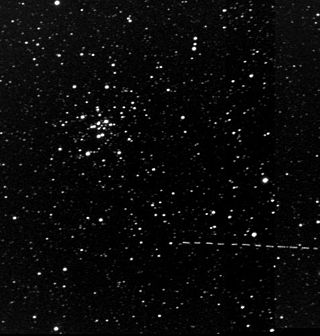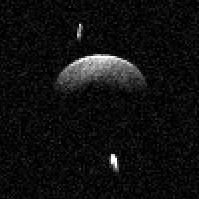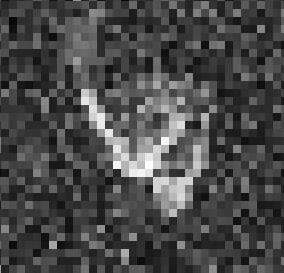4486 Mithra, is an eccentric asteroid and suspected contact-binary, classified as near-Earth object and potentially hazardous asteroid, approximately 2 kilometers in diameter. It belongs to the Apollo group of asteroids and is a relatively slow rotator.

66391 Moshup, provisional designation 1999 KW4, is a binary asteroid, classified as a near-Earth object and potentially hazardous asteroid of the Aten group, approximately 1.3 kilometers in diameter. It was discovered on 20 May 1999, by Lincoln Near-Earth Asteroid Research (LINEAR) at the Lincoln Laboratory's Experimental Test Site in Socorro, New Mexico, United States. It is a Mercury-crosser that comes extremely close to the Sun at a perihelion of 0.2 AU.

(33342) 1998 WT24 is a bright, sub-kilometer asteroid, classified as near-Earth object and potentially hazardous asteroid (PHA) of the Aten group, located in Venus's zone of influence that has frequent close encounters with Mercury, Venus, and Earth. It made a close approach to Earth on 11 December 2015, passing at a distance of about 4.2 million kilometers (2.6 million miles, 11 lunar distances) and reaching about apparent magnitude 11.

(153591) 2001 SN263 is a carbonaceous trinary asteroid, classified as near-Earth object and former potentially hazardous asteroid of the Amor group, approximately 2.6 kilometers (1.6 miles) in diameter. It was discovered by the Lincoln Near-Earth Asteroid Research project at Lincoln Lab's Experimental Test Site in Socorro, New Mexico, on 20 September 2001. The two synchronous minor-planet moons measure approximately 770 and 430 meters and have an orbital period of 16.46 and 150 hours, respectively.
4450 Pan is a highly eccentric asteroid and contact binary, classified as a potentially hazardous asteroid and near-Earth object of the Apollo group, approximately 1.1 kilometers in diameter. It was discovered on 25 September 1987, by American astronomers Eugene and Carolyn Shoemaker at Palomar Observatory in California, United States. It was named after Pan from Greek mythology.

3122 Florence is a stony trinary asteroid of the Amor group. It is classified as a near-Earth object and potentially hazardous asteroid. It measures approximately 5 kilometers in diameter. It orbits the Sun at a distance of 1.0–2.5 AU once every 2 years and 4 months ; the orbit has an eccentricity of 0.42 and an inclination of 22° with respect to the ecliptic. Florence has two moons.

(450894) 2008 BT18 is a sub-kilometer asteroid and synchronous binary system, classified as near-Earth object and potentially hazardous asteroid of the Apollo group. It was discovered on 31 January 2008, by the LINEAR program at Lincoln Laboratory's Experimental Test Site near Socorro, New Mexico, United States. The eccentric asteroid measures approximately 600 meters in diameter and has a composition of a basaltic achondrite.
(5646) 1990 TR is a probable rare-type binary asteroid classified as near-Earth object of the Amor group, approximately 2.3 kilometers in diameter. It was discovered on 11 October 1990, by Japanese astronomers Seiji Ueda and Hiroshi Kaneda at Kushiro Observatory near Kushiro, in eastern Hokkaido, Japan.
(6037) 1988 EG, is an eccentric, stony asteroid, classified as near-Earth object and potentially hazardous asteroid. It belongs to the group of Apollo asteroids and measures approximately half a kilometer in diameter. It was discovered by American astronomer Jeff T. Alu at the U.S. Palomar Observatory, California, on 12 March 1988.

(7482) 1994 PC1 is a stony asteroid, classified as near-Earth object and potentially hazardous asteroid of the Apollo group, approximately 1.1 kilometers in diameter. It was discovered on 9 August 1994, by astronomer Robert McNaught at the Siding Spring Observatory in Coonabarabran, Australia. With an observation arc of 47 years it has a very well known orbit and was observed by Goldstone radar in January 1997. The 2022 approach has been observed every month since August 2021.
(242450) 2004 QY2 (prov. designation:2004 QY2) is an asteroid on an eccentric orbit, classified as near-Earth object and potentially hazardous asteroid of the Apollo group, approximately 3 kilometers (2 miles) in diameter. It was discovered on 20 August 2004 by the Siding Spring Survey at an apparent magnitude of 16.5 using the 0.5-metre (20 in) Uppsala Southern Schmidt Telescope. It is one of the largest potentially hazardous asteroids known to exist.
(163132) 2002 CU11, provisional designation 2002 CU11, is a bright, sub-kilometer asteroid, classified as near-Earth object and potentially hazardous asteroid of the Apollo group. Based on absolute magnitude, it is the second largest asteroid known to have passed closer than the Moon.

(192642) 1999 RD32, provisional designation: 1999 RD32, is an asteroid and suspected contact binary on an eccentric orbit, classified as a large near-Earth object and potentially hazardous asteroid of the Apollo group, approximately 5 kilometers (3 miles) in diameter. It was discovered on 8 September 1999, at a magnitude of 18, by astronomers of the LINEAR program using its 1-meter telescope at the Lincoln Laboratory's Experimental Test Site near Socorro, New Mexico, United States. The asteroid is likely of carbonaceous composition and has a rotation period of 17.08 hours.

(357439) 2004 BL86 is a bright sub-kilometer asteroid and binary system, classified as near-Earth object and potentially hazardous asteroid of the Apollo group, approximately 300 meters (980 ft) in diameter. It was discovered on 30 January 2004 by astronomers of the Lincoln Near-Earth Asteroid Research at Lincoln Laboratory's Experimental Test Site near Socorro, New Mexico. Its 70-meter (200 ft) moon was discovered during the asteroid's close approach to the Earth in January 2015.

2014 JO25 is a near-Earth asteroid. It was discovered in May 2014 by astronomers at the Catalina Sky Survey near Tucson, Arizona - a project of NASA's NEO (Near Earth Object) Observations Program in collaboration with the University of Arizona.

(52768) 1998 OR2 (provisional designation 1998 OR2) is an asteroid on an eccentric orbit, classified as a near-Earth object and potentially hazardous asteroid of the Amor group, with a diameter of 2 kilometers (1.2 mi). It was discovered on 24 July 1998, by astronomers of the Near-Earth Asteroid Tracking (NEAT) program at the Haleakala Observatory, Hawaii. It is one of the brightest and therefore largest potentially hazardous asteroids known to exist. With an observation arc of 35 years, the asteroid has a well-determined orbit, and its trajectory is well known through the year 2197. The asteroid's orbit is only potentially hazardous on a time scale of thousands of years.
2013 GM3 is a micro-asteroid, classified as near-Earth object of the Aten group, approximately 20 meters in diameter. It was first observed on 3 April 2013, by astronomers of the Mount Lemmon Survey conducted at the Mount Lemmon Observatory near Tucson, Arizona, United States.

(505657) 2014 SR339, provisional designation 2014 SR339, is a dark and elongated asteroid, classified as near-Earth object and potentially hazardous asteroid of the Apollo group, approximately 970 meters (3,200 feet) in diameter. It was discovered on 30 September 2014, by NASA's Wide-field Infrared Survey Explorer telescope (WISE) in Earth's orbit. Closely observed at Goldstone and Arecibo in February 2018, it has a rotation period of 8.7 hours.

(164121) 2003 YT1, provisional designation 2003 YT1, is a bright asteroid and synchronous binary system on a highly eccentric orbit, classified as near-Earth object and potentially hazardous asteroid of the Apollo group, approximately 2 kilometers (1.2 miles) in diameter. It was discovered on 18 December 2003, by astronomers with the Catalina Sky Survey at the Catalina Station near Tucson, Arizona, in the United States. The V-type asteroid has a short rotation period of 2.3 hours. Its 210-meter sized minor-planet moon was discovered at Arecibo Observatory in May 2004.
(85182) 1991 AQ, provisional designation 1991 AQ, is a stony asteroid on a highly eccentric orbit, classified as near-Earth object and potentially hazardous asteroid of the Apollo group, approximately 1.1 kilometers in diameter. It was discovered on 14 January 1991, by American astronomer Eleanor Helin at the Palomar Observatory in California. Based on its brightness variation of 0.69 magnitude, this Q-type asteroid is likely elongated. It belongs to the small group of potentially hazardous asteroids larger than one kilometer.

















